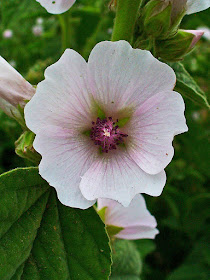Last week's post about the pronunciation of "mauve" created quite a stir. I promised that I would tell you more about this word, and here we are.
We owe the popularity of "mauve" in English to a British chemist, William Henry Perkin (1838–1907). As a student at the ripe old age of 18, Perkin was given the task of chemically synthesizing quinine, which was much in demand as an anti-malaria medication and at the time had to be derived from the bark of the cinchona tree.
Tinkering around in his lab with coal-tar derivatives, Perkin created a substance which, as it turned out, was not quinine, and useless against malaria, but fantastic as a colourfast and fade-resistant rich purple colouring matter. He had stumbled upon the first synthetic dye.
Being a chemist and not a poet, Perkin called it "aniline purple", but he knew he was on to something. Previously, purple dyes had had to be obtained from a Mediterranean shellfish and were so expensive that only royalty wore purple clothes. Still only 19, Perkin plunged his father's life savings into a factory to produce his dye, which others started to call "Perkin's purple". But two years later, in 1859, the more chic-sounding "mauve", borrowed from French (always our go-to language for fashion), took over. I'm not sad about the demise of "Perkin's purple" because can you imagine having to say, "This year's fashion must-have is this lovely Perkin's purple purse." Mauve quickly became all the rage in the fashion industry and Perkin became a very wealthy man.
The French had been using mauve to designate a delicate purple colour since the beginning of the 19th century. It was in fact the name for this plant:
 |
| Malva sylvestris |
Mauve derived from the Latin name of the plant, malva. English had also borrowed this Latin word, as far back as Anglo-Saxon times, but in English it evolved into "mallow". (The Latin name was also revived in the Renaissance -- of course -- and is now commonly used by gardeners.)
One variety of mallow is the "marsh mallow"
The roots of this particular mallow yield a mucilaginous substance that has over the centuries been used in medicinal preparations. Starting in the 19th century, it was also used to give the distinctive texture to the pillowy confectionery item we like to put in our s'mores. Nowadays, gum arabic has replaced the actual marsh mallow, but the name has stuck.
And what is the French word for marshmallow? Guimauve!
For a flower that was even more successful in having a colour named after it, see pink.
For more plant- and gardening-related posts, click here.
S'mores photo by Jessica Ruscello on Unsplash


No comments:
Post a Comment